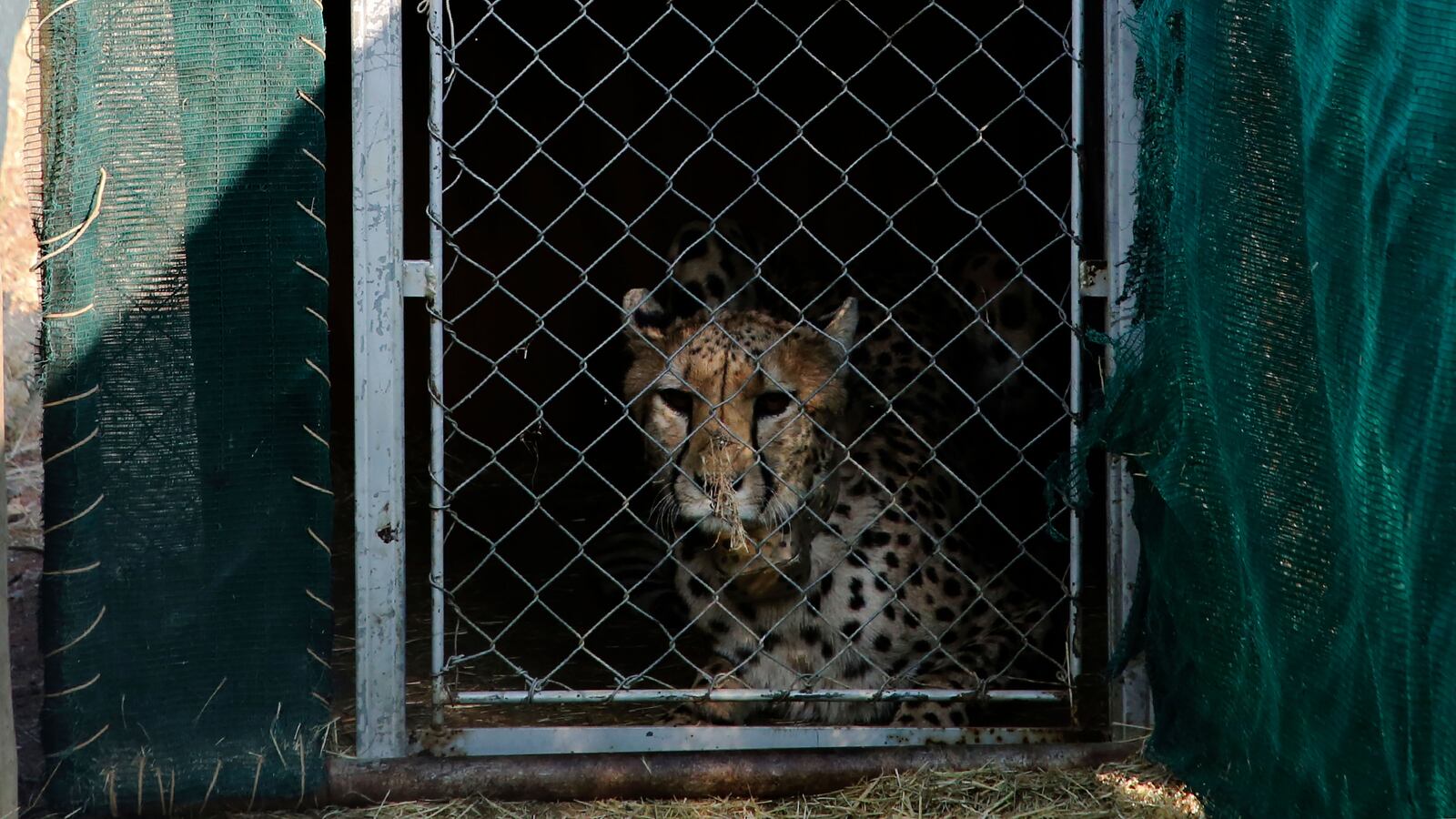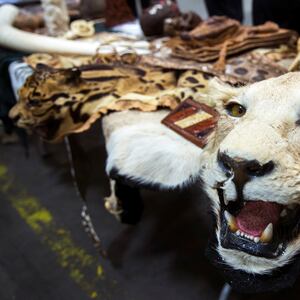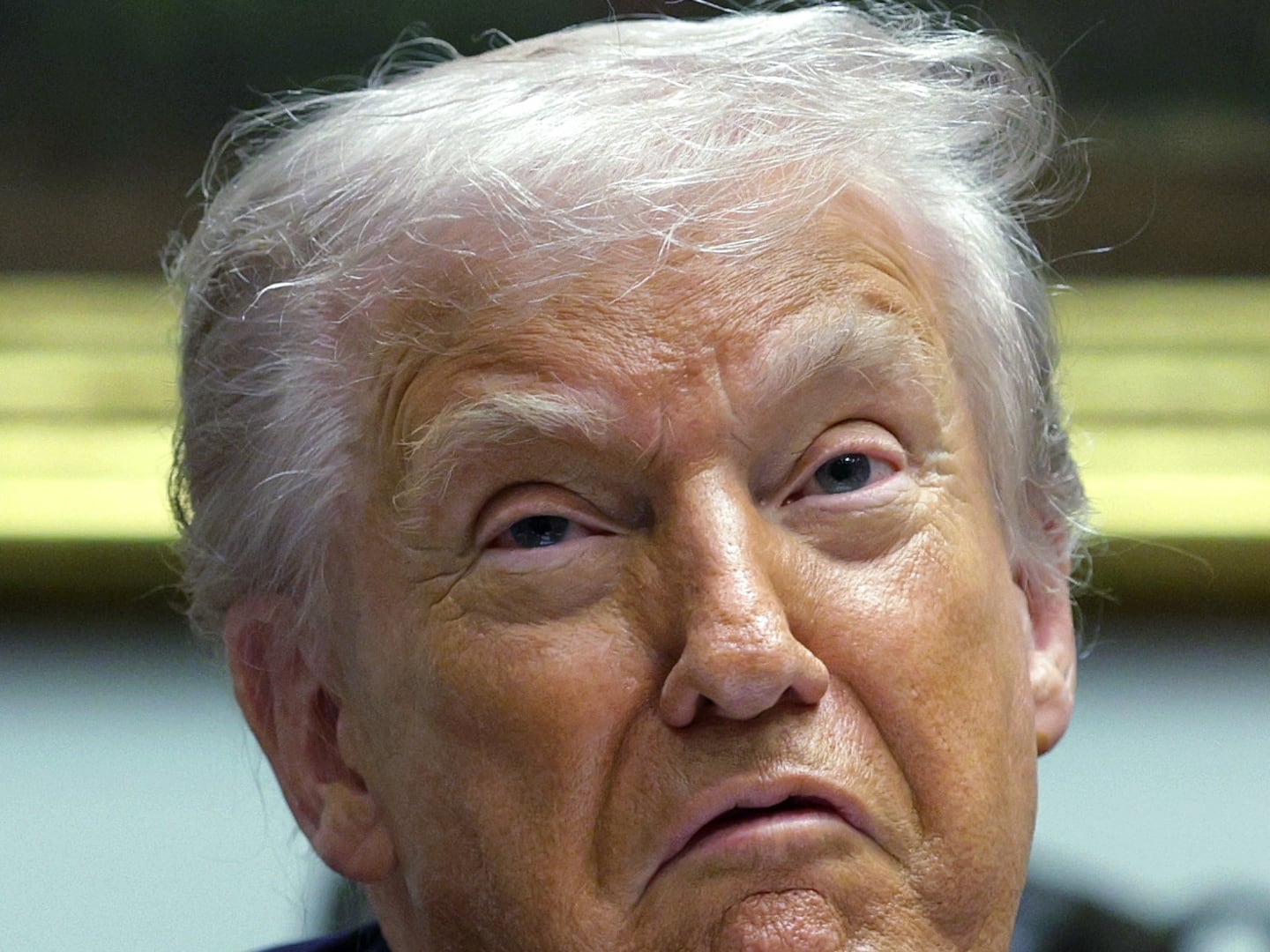Twenty cheetahs were shipped to India from Southern Africa in a historic intercontinental translocation designed to restore the big cats to the country for the first time in 70 years.
The first delivery was timed to coincide with the Indian prime minister’s birthday last year. Amid huge fanfare leading up to the big day, enormous billboards across major cities in the country advertised this achievement of Narendra Modi and his ruling Bharatiya Janata Party.
Cheetahs—the agile big cats known for their remarkable speed and striking appearance—were declared extinct in India in 1952. Now Modi—the most powerful Indian leader in decades—seemed to be saying he could turn back time and bring these beautiful creatures home to a resurgent India.
The results, so far, of this grandiose plan have been tragic.
The first eight cheetahs arrived from Namibia last September, and another 12 cheetahs from South Africa were introduced to the Kuno National Park—located in the central Indian state of Madhya Pradesh—in February this year.
Hopes across the country were sky high, but even before they arrived, scientists and conservationists were raising major concerns about this unprecedented plan.
Kuno National Park emerged as the location for the reintroduction of cheetahs, beating out 10 surveyed sites in five central Indian states, according to the government’s action plan. Studies by conservation researchers, however, disagreed.
The action plan, devised by the Wildlife Institute of India, says that this decision was influenced by Kuno National Park’s “suitable habitat and abundant prey base.” Scientists, again, disagree.

Indian Prime Minister Narendra Modi releases wild cheetahs in Madhya Pradesh, India, on Sept. 17, 2022.
Press Information Bureau/Anadolu Agency via Getty ImagesWhile the ambitious plan to reintroduce cheetahs was being put into action, there were murmurs of concern among India’s wildlife community. They said the plan was “ecologically unsound” besides being costly and “may serve as a distraction rather than help global cheetah conservation efforts.”
Modi ignored their fears. In 2012, the Supreme Court of India had already intervened by putting a stay on the government’s plans to import cheetahs, and in 2013, the apex court reaffirmed its position, emphasizing the necessity for the government to present a comprehensive study before any consideration could be given to introducing cheetahs from Africa.
In 2017, the National Tiger Conservation Authority in India made an appeal to the apex court to reconsider its decision. Following the appeal, the Supreme Court granted permission in 2020 to introduce the cheetah on an “experimental basis.”
Many raised objections.
‘Flawed from the start’
As time passed, the fears of the wildlife community began to materialize as one by one, the big cats started losing their lives. Since March this year, a total of eight—including three cubs born to a Namibian cheetah named Jwala—have lost their lives at the park, adding to the growing toll of cheetah deaths.
Many argued the grand project—which cost $6 million so far—is on the brink of failure.
Dr. Arjun M. Gopalaswamy, a renowned big cat scientist in India told The Daily Beast: “The project was already flawed but now these unforeseen deaths, inexplicable deaths have made it far worse than what we thought.” He says the project is now at a “salvage point.”
India, despite the mounting demographic pressure, has lost only one large wild species of mammals since its independence from the British in 1947—the cheetah. And hence its reintroduction “has a very special significance for the national conservation ethic and ethos.” The Indian government believes that bringing back the cheetah will have “equally important conservation ramifications.”
“In saving it, one would have to save not only its prey base comprising certain threatened species but also other endangered species of the grasslands, some of which are on the brink of extinction,” the Wildlife Institute of India’s action plan says.
“Amongst these are the caracal, the Indian wolf and three endangered species of the bustard family—the Houbara, the lesser florican and the most endangered of all, the great Indian bustard.”
The Indian government also cites the recovery of the wolf in the Greater Yellowstone Ecosystem, Idaho, and Banff National Park as examples of successful human-induced re-establishment of a large carnivore in an ecosystem.
However, several experts have emphasized that the project was implemented without careful consideration and thought—right from its genesis. Several researchers raised concerns about the planned introduction, stating that the decision was made without adequate consideration of the cheetah’s spatial ecology.
Spatial ecology is a scientific discipline that examines the essential impacts of space on the movement patterns of individual species and the overall stability of multispecies communities within an ecosystem.
In a research paper led by Dr. Bettina Wachter—head of the Cheetah Research Project in Namibia—along with Ruben Portas and Joerg Melzheimer for Leibniz Institute for Zoo and Wildlife Research in Berlin, Germany, the team stated that the plan for introducing cheetahs into Kuno National Park assumes that the abundance of prey will support higher cheetah densities, despite the lack of evidence supporting this assumption.
According to these scientists, cheetahs in southern Africa live within a stable socio-spatial system, characterized by widely spread territories and low population densities of less than one individual per 40 square miles.
They pointed out that Kuno National Park’s small size increases the likelihood of released cheetahs moving well beyond the park’s boundaries, potentially leading to conflicts with neighboring villages.
Kuno National Park is small—less than 300 square miles—and experts believe it is a “poor habitat choice” for the cheetahs.
Dinesh Kumar Pandey, a former wildlife warden and conservationist with more than two decades of expertise, told The Daily Beast that the cheetah reintroduction plan was “ill-advised.”
“They should have introduced one or two cheetahs initially, instead of 20.” He thinks experimenting and studying a smaller number of these big cats in the park could have led to a better understanding of how best to save the species. He thinks the cheetah project was a personal vanity project of the Indian prime minister. And the lack of proper planning is now leading to these felines losing lives.
Pandey also believes that people who were involved in the project in India didn’t have any experience dealing with the species. And so when eight cheetahs died within a span of a few months after their move, nobody knew what was going on.
In a letter authored by Gopalaswamy—co-signed by eight conservationists from South Africa, Portugal, the Netherlands, Australia, and India—and published in the journal Nature Ecology & Evolution, the scientists said the translocation plan is based on “unsubstantiated” claims that cheetahs in Africa have depleted their habitat space, that India possesses adequate room for them, and that conservation translocations have been proven successful.
“Given India’s demonstrated political will to save cheetahs as a way of correcting historical ecological wrongdoing, we recommend that India redirect its initial, massive ‘Project Cheetah’ investment of £48 million [$61.6 million] towards global cheetah conservation efforts involving extensive habitat protection, ensuring adequate wild prey, ensuring connectivity between populations and enhancing human–cheetah relations,” the letter read. “These should preferably be in other parts of Asia (for example, Iran) but could also be in Africa, where cheetahs—though under severe pressure—still remain extant in 3.1 million square kilometers.”
Former Indian environment minister Jairam Ramesh also joined the chorus of voices hitting out at Modi’s government over its handling of the cheetah reintroduction program. He said if “science” rather than “vanity” had been put at the forefront of the project “we may not have witnessed the current tragedy.”
On the Defensive
Amid all the criticism, drama and politics of the big cat deaths, the government of India stayed defiant. There were also claims that the officials responsible for overseeing the project in India neglected to share crucial monitoring information with experts supporting the project from Africa.
Despite a lack of transparency, the government of India’s Ministry of Environment, Forest and Climate Change stuck to their guns. In a statement after two cheetahs died within days of each other earlier this month, government officials said, “Cheetah has been brought back to India after seven decades and a project of such a stature is bound to undergo ups and downs”.

A cheetah is loaded into a truck before being flown from South Africa to India, at Rooiberg veterinary facility, Limpopo province, South Africa, on Feb. 17, 2023.
Siphiwe Sibeko/ReutersThe statement added: “Global experience particularly from South Africa suggests that in the initial phase of reintroduction of Cheetah in African countries has resulted in more than 50 percent mortality of introduced Cheetahs.”
The authorities rubbished reports that said that at least two cheetahs died due to skin infections caused by radio collars used to track the big cats in the wild. The environment ministry attributed the deaths to “natural causes.”
And yet, on July 24, the radio collars were removed from at least six cheetahs in the Kuno National Park. The Indian government also removed Madhya Pradesh’s chief wildlife warden, Jasbir Singh Chauhan from his post after the deaths of two of the magnificent felines in quick succession. Chauhan is a widely respected wildlife expert in India whose removal shocked the community.
The Supreme Court of India said last week that the eight cheetah deaths in less than one year at the Kuno National Park don’t present a “good picture” and asked the Modi administration to not make it a point of prestige—and instead explore the possibility of shifting the big cats to other wildlife sanctuaries.
Sources inside Kuno National Park told The Daily Beast: “The Cheetah action plan says that there is space for 21 cheetahs in the park. Anybody with an iota of knowledge about population management and dynamics can understand that all cheetahs should not be released from their enclosures into the wild. We are putting all our eggs in one basket.”
The top officials at the Kuno National Park had allegedly sent a letter to the ministry in April, looping in the apex authority on big cats, the National Tiger Conservation Authority [NTCA] and the Wildlife Institute of India. In the letter, the officials recommended that some of the cheetahs be shifted to other places that had been surveyed earlier for cheetah translocation.
As per the action plan, at least 10 potential sites—encompassing the states of Rajasthan, Madhya Pradesh, Gujarat, Chhattisgarh and Uttar Pradesh had been surveyed in terms of the size and quality of the available habitat, prey base and scope of future development. Ultimately, three sites were recommended: Kuno-Palpur and Nauradehi Wildlife Sanctuaries in Madhya Pradesh and Shahgarh area in Rajasthan.
“They [BJP government] wanted to keep all the cheetahs here [in the Kuno National Park] in Madhya Pradesh,” the source said. The receipt of the letter was not even acknowledged.
Madhya Pradesh is ruled by BJP. In Rajasthan, the chief minister is from the Indian National Congress—one of the biggest opposition parties in the country and BJP’s archrivals.
Can the Big Cats Be Saved?
The veteran conservationist Pandey told The Daily Beast that the project needs to be steered in the right direction at this time. It will be a waste otherwise.
He says that now the team that is overseeing the project will need to put their heads down and find out the reason behind these casualties. And then figure out solutions together, so other cheetahs are saved from facing a similar fate.
Gopalaswamy, however, says there are no easy answers. “They started off with a bad plan. They ended up having too many [cheetahs]. It’s a very difficult situation. Now what are you going to do with them?”
However, managing fewer cheetahs does not necessarily imply an easier task. Gopalaswamy says: “Demographic and environmental stochasticity will drive the population to extinction in a very short period of time.”
In simpler terms: in smaller populations, chance occurrences such as deaths or births exert a stronger influence on the overall population size. For instance, a random event leading to the demise of a few cheetahs within a small population can disproportionately impact the group, unlike larger populations where such fluctuations may have a less significant effect due to dilution. Environmental fluctuations—including food availability, climate variations, and habitat changes—can have a more pronounced effect on smaller populations too.
Despite all of these risk factors, the Indian Ministry of Environment and Forests predicted in a 2010 report that “Thanks to Project Cheetah, the cheetah may well roam the plains of India again.”
But going by the current mortality rate of the cheetahs, achieving that dream might take many more years. And if they can’t stop the mortality of cheetahs at the Kuno National Park, Pandey added, it would be better to return them to their native habitat in Africa.








